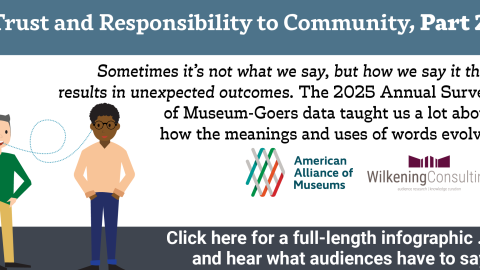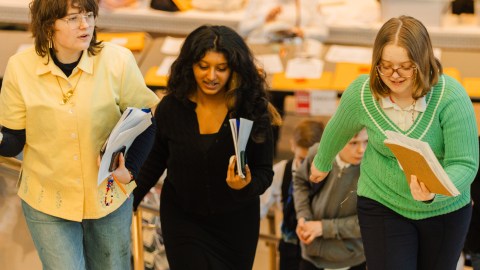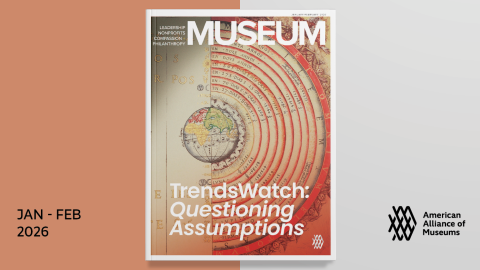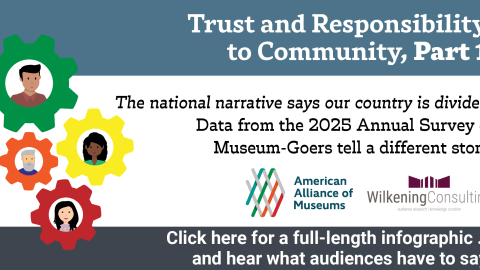Yesterday I attended an event at the Hirshhorn organized by the Smithsonian Center for Learning and Digital Access, exploring the use of digital badges in museums. It was a great session, and you can watch a recording of the whole thing here.
However, while I attended to hear about digital badging (since we’re about to launch CFM’s own digital badging prototype, with the help of our volunteer test pilots) what I want to share now is what Max Anderson had to say about DMA Friends, the Dallas Museum of Art’s new membership program.
You can read more about the DMA’s membership experiment here. Basics are:
- Admission is free
- Basic membership level is free
- Visitors are encouraged to sign up for a free membership, and provide contact info
- Visitors can earn points, and badges, from various forms of engagements
- Engagement can be tracked when visitors scan their membership card to check into various locations, including specific galleries
- Points can be redeemed for a variety of things, right up to spending a night in the museum.
The system premiered in January, so it’s too soon to assess the impact on things like diversity of audience, long term engagement and the financial model. Anderson estimates they are signing up 80–90 new members a day, over 90% of whom were not already in their database. (About 9% are existing members trading their paid membership for a free membership.)
Some things that caught my interest:
About the points awarded for engagement:
- The points DMA awards for participation truly are turning into an “alt currency” that has real world value. The higher level of DMA membership (Museum Partner) costs $100, but visitors can “earn” the membership with points rather than plonking down the cash. They also can redeem points for things like free admission to ticketed special exhibits and free parking. They have given away over 7.7 million points since they started.
- These points have their own, unique value—Anderson noted “even wealthy people want points!”
- Anderson proposed that in the future, these points might become a shared currency between museums that opt into a kind of currency exchange: I could redeem my points earned at the DMA, for example, for perks offered by the Cleveland Museum of Art. Could this be the museum equivalent of Bitcoins? (Hopefully without the crash.)
- This system facilitates targeted communications: for example, emailing people who have amassed enough points for free admission to a special exhibit, to remind them of the opportunity and invite them to come.
- It provides opportunities for spontaneous and personalized feedback. Staff, for example, can award a visitor with points for asking a great question.
About the data the museum collects on its members:
- DMA uses a zip code search to track where people are from, and cross-references that with the Census data to get a demographic snapshot. This data can tell them not only who is (and isn’t) attending, but when, and what parts of the museum they are visiting. True, many museum have long collected this kind of data, but DMA’s membership structure is designed specifically to capture as many people, and as much data, as possible, and mine that for all it is worth.
- Real time data from the swipe cards facilitates improvisation. For example, if staff notice that a critical mass of people have swiped into a given gallery, they can send a text message offering a guided tour. (Contrast this with the pre-scheduled “There will be a gallery talk at 2 p.m.” dang-I-missed-it experience.
- Points, and how they are redeemed, gives the museum real and immediate feedback on what people would like to receive points for—what motivates them?
About the financial model underlying the experiment:
- DMA has decided to value participation first, and trust that cash will come along with that
- Behind that general optimism, however, lies the shrewd observation that “the true currency of participation does not cost that much to offer.” In other words, much of what a museum friend earns with points costs the museum nothing (extra) to provide
- And often people who redeem the points for things like free admission to special exhibits bring along (paying) guests
- In any case, the museum had already figured out that any membership that cost less than $100 was a net loss, since it cost more to support than it brought in
- This system of data collection enables them to compile a detailed and compelling story to tell funders about who the DMA is serving, how they engage with the museum and what they learn
My big three take-aways:
- It’s about creating a system that addresses the two things CFM lecturer Jane McGonigal noted museums usually are bad at: providing clear instructions and good feedback
- It’s all about the data—data will, in one way or another, prove to be the most valuable thing you can ask for as an entry level of engagement—more valuable than cash for a ticket or a basic membership fee
- It’s about building a business model based on the long-term payoff of relationships, rather than immediate exchanges of money for goods or services
It’s clear that DMA sees this experiment as a great leap forward in creating a more egalitarian, accessible museum. Maybe from this video they created (parodying Downton Abby) you can deduce how they assume people used to see them, and what this “class revolution” may achieve.








